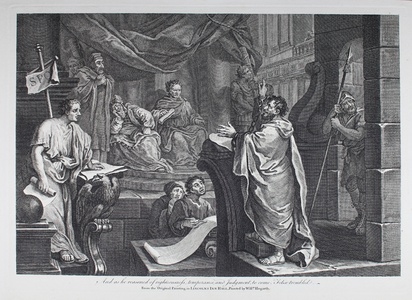| Method | Copper engraving |
| Artist | after William Hogarth |
| Published | From the Original Painting in Lincolns Inn Hall, Painted by Willm. Hogarth. [Robert Sayer. London, 1767] |
| Dimensions | Image 235 x 345 mm, Plate 258 x 360 mm, Sheet 280 x 450 mm |
| Notes |
A reduced engraving after Luke Sullivan's engraving of Hogarth's painting of Paul Before Felix, from Robert Sayer's Les Satyres de Guillaume Hogarth Oeuvre Moral et Comique. Sayer published Les Satyres under the auspices of Jane Hogarth, who had been granted copyright over her late husband's works by Act of Parliament. The scene features St Paul preaching before the Roman procurator of Judea, Marcus Antonius Felix. Paul stands in chains before Felix in the courts of Caesarea. The painting was commissioned by William Murray for decorating Lincoln's Inn Hall, so it was appropriate for Hogarth to choose a court scene. At the same time, the commission allowed Hogarth to exercise his skill as a painter of heroic scenes drawn from biblical and classical sources in a manner directly comparable to Rembrandt's St. Paul cartoons. A quotation (Acts 24:25) inscribed below image reads: And as he reasoned of righteousness, temperance, and judgment to come, Felix trembled. Sullivan's engraving differs from that of Hogarth's only in that it is not reversed, features fewer figures, and has been done in a classicizing style. William Hogarth (1697 - 1764) was born in London, the son of an unsuccessful schoolmaster and writer from Westmoreland. After apprenticeship to a goldsmith, he began to produce his own engraved designs in about 1710. He later took up oil painting, starting with small portrait groups called conversation pieces. He went on to create a series of paintings satirising contemporary customs, but based on earlier Italian prints, of which the first was The Harlot's Progress (1731), and perhaps the most famous The Rake's Progress. His engravings were so plagiarised that he lobbied for the Copyright Act of 1735, commonly referred to as 'Hogarth's Act,' as a protection for writers and artists. During the 1730s Hogarth also developed into an original painter of life-sized portraits, and created the first of several history paintings in the grand manner. Luke Sullivan (1705 - 1771) was a London-based Irish engraver and miniature painter. He was supported in his early career by the Duke of Beaufort, his father having worked for the Duke as a groom. His best known works were completed as an assistant to William Hogarth, though Hogarth was reputed to have had difficulty working with Sullivan, owing to the latter's erratic behaviour and frequent absences. Later in his career he worked on engravings of various British views, including that of Stonehenge for Grose's 'Antiquities of England and Wales,' as well as having some success as a miniaturist with the Society of Artists. Robert Sayer (1725-1794) was one of the most prolific and successful British publishers, cartographers, and print-sellers of the Georgian era. Following his brother's marriage to the daughter in law of the publisher John Overton, Sayer continued the business, branching out into sea charts, maritime atlases, and general maps. In addition to his cartographic achievements, Sayer was also instrumental in growing the public taste for prints after paintings, particularly those by Johan Zoffany, with whom he developed a lifelong friendship as well as a lucrative business partnership. Following his death, the business was continued by Laurie and Whittle. Condition: Excellent impression. Minor time toning and surface dirt to edges of sheet, not affecting plate. |
| Framing | unmounted |
| Price | £75.00 |
| Stock ID | 50693 |

